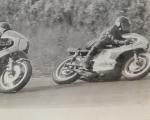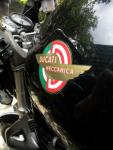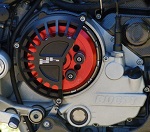|
BLEEDING THE REAR BRAKE SYSTEM
Connect bleeding tool to left-hand front brake calliper bleed valve (3) or to rear brake bleed valve (8).
Note
Follow the manufacturer's instructions when using a commercial brake bleeding tool. Suck with the bleeding tool and open the bleed valve (3) making sure that the level of the concerned reservoir does not fall below the "MIN" mark.
Continue this operation until all air is bled out of system.
Tighten bleed valve (3) to a torque of 4Nm ± 10%.
Warning
Dispose of oil and/or filter cartridges in compliance with environmental protection regulations.
Press pedal to make half stroke or until system is pressurised, open bleed valve and let pedal make full stroke; tighten bleed valve to the specified torque and release pedal.
Important
Do not release the brake pedal until the bleed valve has been fully tightened. Repeat the operation until the fluid inside system is free of air bubbles. Make sure that, with bleed valve duly closed, pressure is correctly developed through brake pedal. Tighten bleed valve (3) to a torque of 4Nm ± 10%, and fit protective cap.
BLEEDING THE FRONT BRAKE SYSTEM
Fill the reservoir (2) with the specified fluid taken from an intact container.
Important
During this operation, fluid level inside reservoir must remain above the MIN mark at all times. The end of the transparent plastic hose must remain immersed in the discharged fluid at all times.
Operate brake lever or pedal and keep them operated during the whole filling operation.
Connect bleeding tool to left-hand front brake calliper bleed valve (5).
Note
Follow the manufacturer's instructions when using a
commercial clutch bleeding tool. Suck with the bleeding tool and open the bleed valve (5) making sure that the level of the concerned reservoir does not fall
below the "MIN" mark. Continue this operation until all air is bled out of system.
Tighten bleed valve (5) to a torque of 4Nm ± 10%.
If you do not have a bleeding tool available, connect a transparent plastic tubing to the bleed valve (5) as outlined in the draining procedure. Operate the lever to make half stroke or until system is pressurised, open bleed valve and let lever make full stroke; tighten bleed valve to the specified torque and release lever.
Important
Do not release the brake lever until the bleed valve has been fully tightened.
Repeat the bleeding operation until the fluid inside system is free of air bubbles; once filling is completed, proceed to bleeding by working on all system valves, one at a time.
Then repeat bleeding procedure on right-hand front calliper valve (5).
In particular, to completely eliminate any air possibly trapped at the highest point of the front brake master cylinder, perform the same procedure on the bleed valve (6), after having loosened nut (7) and connected bleeding tool to the transparent plastic
tubing, as outlined in the draining procedure.
Make sure that, with bleed valves duly closed, pressure is correctly developed through brake lever or pedal.
Tighten bleed valves (5) and nut (7) to a torque of 4Nm ± 10%, and fit protective cap. Level fluid and refit cover (1) by tightening screws (3) on reservoir (2)
|










 Roast Beef Monster!
Roast Beef Monster!


 Linear Mode
Linear Mode

